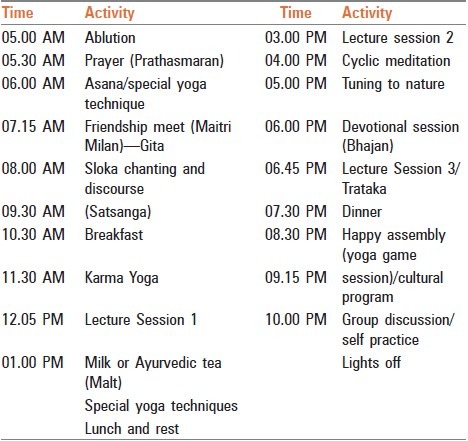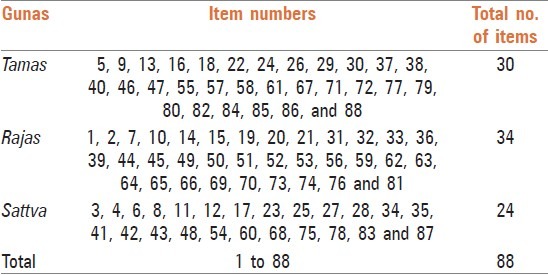Abstract
Background:
Academic excellence is essential to provide opportunities for students to work together to improve their understanding of concepts in their academic core. Academic excellence helps students to teach problem-solving and collaborative learning strategies.
Objective:
The objective of this study was to assess Guna (personality traits) in students undergoing Yoga Instructor's Course (YIC).
Materials and Methods:
In all, 68 YIC students with a mean age of 28.03 ± 9.38 years participated in this single group pre–post study. The Personality Inventory data were collected before (pre) and after (post) the YIC.
Statistical Analysis:
Means, standard deviations, Kolmogorov–Smirnov test, and Wilcoxon signed rank test were used for analyzing the data with the help of SPSS 16.
Results:
The data analysis showed 11.33% decrease (P < 0.01) in Tamas Guna (dull personality trait), 0.68% decrease (P =0.819) in Rajas Guna (violent personality trait), and 10.34% increase (P <0.01) in Sattva Guna (balanced personality trait) scores.
Conclusion:
This study suggests that YIC can result in the improvement of Sattva Guna (balance personality trait) among students, thus paving the way for their academic excellence.
KEY WORDS: Academic excellence, ancient science of yogic life, university students
INTRODUCTION
Indian philosophy provides Guna theory, a composite framework of Tri-dimensional Personality Inventory to aid the understanding of the mental make-up of a person. This theory is based on Samkhya Philosophy's concept of Guna.[1,2] In an ideal situation of perfect health, an individual has the complete freedom to use any of these three Gunas with dominance of Sattva Guna in his personality. Ill health or limited health occurs if Rajas or Tamas Guna becomes dominant, as one loses freedom and gets habituated to either of these Guna. Hence, the degree of positive health can be measured by a tool that can grade these three personality traits or Guna.[3]
The philosophy of yoga believes that somatic problems are nothing but a manifestation of an imbalance between three Gunas (Sattva, Rajas, and Tamas) that go to constitute the body–mind complex of the individual.[4] Further, in the famous scriptural text, the Gita, a guna, indicates a specific behavior style. Sattva is symbolized by purity, wisdom, bliss, serenity, love of knowledge, spiritual excellence, and other noble and sublime qualities. Rajas is symbolized by egoism, activity, restlessness, and hankering after mundane things such as wealth, power, valor, and comforts. Tamas is related to qualities such as bias, heedlessness and inertia, perversion in taste, thought, and action.[5]
However, the personality changes that characterize the efficacy of Integrated Approach of Yoga Therapy (IAYT) for students have not been reported adequately. Hence, we have designed this study to assess the efficacy of Yoga Instructor's Course (YIC) for academic performance in university students using Personality (Guna) Inventory (PI).
Objective
The objective was to assess PI in university students undergoing YIC.
MATERIALS AND METHODS
Subjects
In all, 68 YIC students (27 males and 41 females) with a mean age of 28.03 ± 9.38 years participated in this study.
Inclusion criteria
Age range 18 and 37 years
Both males and females
Exclusion criteria
Students with serious medical conditions
Students taking medication
Using any other wellness strategy
Students using psychiatric drugs, alcohol, or tobacco in any form
Design
A single group pre–post study
Source
The subjects for this study were selected from Swami Vivekananda Yoga Anusandhana Samsthana (S-VYASA) University, Bangalore, undergoing a 21-day YIC program.
Informed consent
An informed consent was obtained from all the participants.
The institutional review board (IRB) approval
The study was approved by the IRB of S-VYASA University.
Assessments
In this study, we have used PI developed by Pathak, Bhatt and Sharma.[6] It has 24 items for Sattva Guna (balanced, gentle, and controlled personality trait), 34 items for Rajas Guna (violent and uncontrolled personality trait), and 30 items for Tamas Guna (dull and uncontrolled personality trait). It has good internal consistency and reliability and in terms of validity, all the three traits showed low correlation with each other indicating that these three traits are independent.
PI is based on Samkhya Philosophy's concept of Guna.[1] In an ideal situation of perfect health, an individual has the complete freedom to use any of these three Gunas with dominance of Sattva Guna in his personality. Ill health or limited health occurs if Rajas or Tamas Guna becomes dominant, as one loses freedom and gets habituated to either of these Guna. Hence, the degree of positive health can be measured by a tool that can grade these three personality traits or Guna.[3]
Intervention
All the subjects participated in the YIC of 21 days duration [Table 1]. The program was conducted in a serene and peaceful atmosphere of the S-VYASA University in a residential setup with a schedule starting from 5 AM to 10 PM. Sattvic diet (high-fiber low-fat vegetarian and balanced diet), devotional sessions, cultural programs, and discourses from experts were the key essence of this program. The program was based on IAYT leading to the holistic development of the personality.
Table 1.
Schedule of the YIC program

Data collection
The PI data were collected before (pre) and after (post) the 21-day YIC program.
Data analysis
Tables 2, 3, and 4 show the items in their respective Guna (personality) with their interpretation and test–retest reliability co-efficient. Responses to inventory items are received in terms of choices between very much, much, moderate, little, or not at all. These raw answers are then converted to numerical values from 5 to 1, respectively. Answers to all items on all three scales are converted to 5, 4, 3, 2, or 1, as above. Addition of scores on all items on a particular scale gives the individual's total score on that scale. In this way, each individual receives a score on each of the three scales. Percentage of each was calculated by dividing the score of each Guna with total score and multiplying by 100.
Table 2.
Interpretation of Guna (Personality) inventory scores

Table 3.
Test–retest reliability co-efficient of Guna
![]()
Table 4.
Interpretation of Guna scores

Statistical analysis was done with the help of Statistical Package for Social Sciences [SPSS]-16. The Kolmogorov–Smirnov test showed that the data were not normally distributed. We used the Wilcoxon signed rank test to compare means of the data collected before (pre) and after (post) the YIC program.
RESULTS AND DISCUSSION
The data analysis showed 11.33% significant decrease (P < 0.001) in Tamas Guna (dull personality trait), 0.68% decrease (P = 0.819) in Rajas Guna (violent personality trait), and 10.34% significant increase (P < 0.001) in Sattva Guna (balanced personality trait) scores [Table 5].
Table 5.
Data analysis

The behavior of a human being is an expression of a combination of different Gunas. Tamas (meaning darkness) is the grossest aspect of our personality characterized by excessive sleep, innocence, laziness, depression, procrastination, a feeling of helplessness, impulsivity, anger, and arrogance (packed up with vital energy). When we reduce Tamas through mastery over the mind, we become dynamic, sensitive, and sharp to move toward Rajas (the shining one) characterized by intense activity, ambitiousness, competitiveness, high sense of self importance, desire for sense gratification, little interest in spiritual elevation, dissatisfaction with one's position, envy of others, and a materialistic cleverness.[7]
With further growth and mastery, one moves into Sattva—a dominance that includes the qualities of truthfulness, stability, discipline, sense of control, sharp intelligence, preference for vegetarianism, truthfulness, gravity, dutifulness, detachment, respect for superiors, staunch determination,[8] and stability in the face of adversity and also conscious action. Thus, we can see that although both Rajas and Tamas have both positive and negative qualities, they are the manifestation of a violent state of mind in which a person lacks mastery over upsurges of emotions and impulsive behavior.[7] Most of the qualities of Sattva which are manifestation of a calm state of mind are achievable by different yoga techniques (physical postures, pranayama, and/or meditation) meant for mastery over the mind–body complex.[9] Several earlier studies have independently corroborated these notions. It has been shown that self-esteem as well as the sense of control and determination improved after meditation.[10] Reduction in crime rate after transcendental meditation (TM) supported the effect of a calm state of mind on social health.[11] These positive effects also show up as better perception and memory as well as better motor performance (dexterity and coordination tests).[12]
The mechanism of how yoga may reduce Rajas and Tamas and how it may increase Sattva may be understood by three cardinal principles of yoga: relax the body, slow down the breath, and calm down the mind.[13] Recent research has shown a positive relationship between personality trait and academic performance. A previous study on yoga reported enhanced PI as a result of the practice of yoga way of life. The result indicates the importance of yoga to improve academic performance.[14,15] This study is consistent with these findings, indicating that a systematic practice of the yoga in the form of YIC can result in better academic excellence.
CONCLUSION
This study suggests that YIC can result in the improvement of Sattva Guna (balance personality trait) among students, thus paving the way for their academic excellence.
ACKNOWLEDGEMENT
The authors acknowledge S-VYASA University for granting permission to carry out this work.
Footnotes
Source of Support: Nil.
Conflict of Interest: None declared.
REFERENCES
- 1.Deshpande S, Nagendra HR, Raghuram N. A randomized control trial of the effect of Yoga on Gunas (personality) and Self esteem in normal healthy volunteers. Int J Yoga. 2009;2:13–21. doi: 10.4103/0973-6131.43287. [DOI] [PMC free article] [PubMed] [Google Scholar]
- 2.Woodroofe SJ. Madras: Ganesh and Company; 1972. Shakti and Shakta. [Google Scholar]
- 3.Goyanka J. Gorakhpur: Gita Press; 1999. Srimadbhagavadgita Tattvavivecani, Govind Bhavan Karyalaya. [Google Scholar]
- 4.Goyandka J. 15th ed. Gorakhpur, Govind Bhavan Karyalaya: Gita Press; 1999. Srimadbhagavad gita Tattvavivecani. [Google Scholar]
- 5.Das RC. Standardization of the Gita inventory of personality. J Indian Psychol. 1991;09:47–54. [Google Scholar]
- 6.Pathak NS, Bhatt ID, Sharma R. Manual for Classifying Personality on Tridimensions of Gunas- An Indian Approach. Indian J Behav. 1992;16:4. [Google Scholar]
- 7.Deshpande S, Nagendra HR, Raghuram N. A randomized control trial of the effect of Yoga on Gunas (personality) and Health in normal healthy volunteers. Int J Yoga. 2008;1:2–10. doi: 10.4103/0973-6131.36785. [DOI] [PMC free article] [PubMed] [Google Scholar]
- 8.Wolf DB. The vedic personality inventory: A study of the Gunas. J Indian Psychol. 1998;16:26–43. [Google Scholar]
- 9.Holt WR, Caruso JL, Riley JB. Transcendental Meditation vs pseudo-meditation on visual choice reaction time. Percept Motor Skills. 1978;46:726. doi: 10.2466/pms.1978.46.3.726. [DOI] [PubMed] [Google Scholar]
- 10.Alexander CN, Robinson P, Rainforth M. Treating and preventing alcohol, nicotine and drug abuse through transcendental meditation: A review and statistical meta-analysis. (13-87).Alcohol Treat Q. 1994;11:1–2. [Google Scholar]
- 11.Abrams AI. Transcendental meditation and rehabilitation at Folsom prison: Response to a critique. Criminal Justice Behav. 1979;6:13–21. [Google Scholar]
- 12.Dillbeck MC, Orme-Johnson DW. Physiological differences between transcendental meditation and rest. Am Psychol. 1987;42:879–81. [Google Scholar]
- 13.Murthy SR. From local to global - Contributions of Indian psychiatry to international psychiatry. Indian J Psychiatry. 2010;52:30–7. doi: 10.4103/0019-5545.69202. [DOI] [PMC free article] [PubMed] [Google Scholar]
- 14.Kember P. The Transcendental Meditation technique and postgraduate academic performance. Br J Educ Psychol. 1985;55:164–6. [Google Scholar]
- 15.Ganpat TS, Nagendra HR. Yoga therapy for developing emotional intelligence in mid-life managers. J Mid-life Health. 2011;2:28–30. doi: 10.4103/0976-7800.83267. [DOI] [PMC free article] [PubMed] [Google Scholar]


